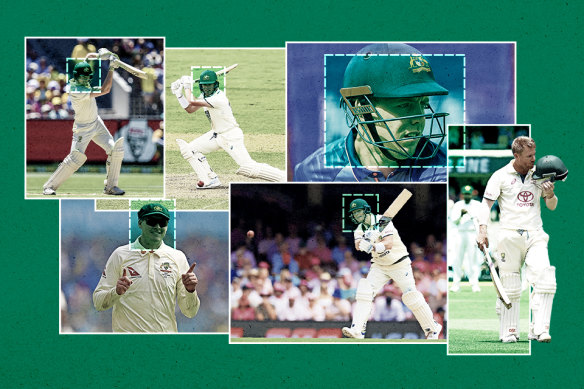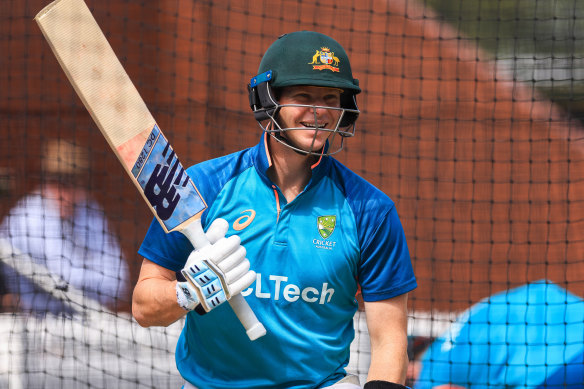This was published 1 year ago
Who replaces Warner? Rating five candidates – including Smith at the top
Now that David Warner has officially farewelled Test cricket, selectors have a big call to make on the veteran opener’s successor.
By Tom Decent

Candidates to replace David WarnerCredit: Aresna Villaneuva
Life after David Warner has finally become a reality for the Australian men’s Test team.
The retirement of the veteran opener leaves a void at the top of the order, and the identity of the man who should fill it is the subject of debate by fans all around the country.
Selectors are often forced to make changes when players are out of form, but Australia have the luxury of coming off a series whitewash against Pakistan which underlined their status as the No.1-ranked Test team in the world.
Australia’s next assignment is a two-Test series against an under-strength West Indies in Adelaide (starting January 17) and Brisbane which, to be brutal, should end in nothing other than a 2-0 series win.
Selectors will name a squad this week – potentially on Wednesday – which should give a big clue regarding Warner’s long-term replacement. Whoever gets the nod is almost certain to be given both Tests against the West Indies to lock down the spot.
Here are the five best options for selectors to consider.
Steve Smith
The most fascinating candidate is undoubtedly Smith, whose name wasn’t even in the conversation a week ago. As Marnus Labuschagne, Travis Head and Mitch Marsh were all asked for their views across the summer about whether they’d be prepared to make the leap to the top of the order, everyone assumed Smith would not budge from the No.4 spot with which he has been synonymous.
That was until Smith told the ABC after play on day three he was “certainly” interested in a switch up the order – something coach Andrew McDonald confirmed the 34-year-old had previously discussed with others in the Australian set-up.
Smith has never opened in Tests, first-class cricket or one-day internationals, though he has occasionally in T20 cricket. However, he is used to facing a new ball, as happens when wickets fall early in an innings.
The last time Smith did not bat at No.4 in a Test for Australia – excluding when a nightwatchman was sent in – was when he captained the team against Bangladesh in Chattogram in 2017.
Smith’s Test average of 58.01 from 105 Tests speaks for itself, but his technique is unorthodox compared to most classical opening batsmen. Smith tends to move around the crease more than most, which could bring him unstuck when the new ball is swinging and seaming in the first overs of an innings.
There were some initial questions over whether Smith’s technique would hold up in England, but his record there is phenomenal.
Few cricketers are as absorbed in the sport as Smith, and selectors could be confident he would direct all his energies into succeeding at a new role. As long as selectors believe Smith can be more profitable there, and that it would not expose the top order, it could be a masterstroke. If he did open, Cameron Green could slot into No.4, with Labuschagne above him and Head and Marsh remaining at five and six.

Steve Smith in the nets.Credit: Getty
Cameron Green
Like Smith, Green is not a traditional opener. He has only batted at No.6 and No.7 in Tests, but has been given opportunities at No.4 with Western Australia.
While Green does not often face a new red ball, his defence is sound – a non-negotiable for an opener.
Selectors know Green, 24, has a huge future and are eager to squeeze him into the side where he was a regular before Marsh forced his way back in.
Green is comfortable against high-class fast bowling and grew up playing on bouncy pitches in WA, a good grounding for the challenge of opening.
It is very rare, though, for a pace bowler to open the batting, which is why Green has previously occupied a spot in the middle order.
The overall consensus within the Australian cricket hierarchy is that the quicker Green gets to No.4, the better.
Opening might be a stepping stone to that, but few believe it is the best place for him in the long term.
Green made 96 against Queensland at the Gabba in his only Sheffield Shield match this season, Mark Waugh has said he would be keen to see Green open against the West Indies.
Cameron Bancroft
It has been more than six years since Bancroft first opened for Australia, in late 2017 against England in Brisbane. He made five in Australia’s first innings before an impressive unbeaten 82 alongside Warner (87 not out) to win the Test.
Had Bancroft not been caught up in the ball-tampering scandal of 2018, he may never have lost his spot at the top of the order.
After serving his ban, Bancroft’s recall for the 2019 Ashes yielded scores of 8, 7, 13 and 16 before he was dropped for Marcus Harris. By March 2020, Bancroft was out of the WA Shield team.
But the 31-year-old has returned to form in the last two seasons, scoring more runs than anyone in the 2022-23 Shield season (945 at 59.06 with four hundreds) before backing it up this season with 512 runs at 56.88 with two centuries. In the selection equation, runs are the most important currency and Bancroft has made them in spades.
West Australians are adamant he must be the man to replace Warner, while Australia’s all-time leading run-scorer, Ricky Ponting, has nominated Bancroft as the next player up.
Marcus Harris
A record of 607 runs at 25.29 from 14 Tests has hardly convinced Australian supporters that Harris should be Warner’s replacement.
The hard thing for Harris is that he has been waiting in the wings for so many years, often within squads and running the drinks.
The 31-year-old has chalked up 282 runs in this Shield season at an average of 31.33. The season before he made 601 runs at 37.56.
Harris peeled off 126 against Pakistan in a tour match late last month. If selectors wanted a slightly more attacking player like Warner, Harris has a higher first-class strike rate (52.80) than Bancroft (42.89) and Matt Renshaw (48.51).
Harris does have a Cricket Australia contract, which shows he is held in high regard.
Matt Renshaw
When comparing recent numbers, Renshaw is not setting the world on fire. From 11 Shield innings this season, he has made 348 runs at 31.63.
However, Renshaw did make 136 not out in a Prime Minister’s XI game against Pakistan last month to put himself in contention.
Renshaw has played 14 Tests for Australia since debuting in 2016. He is also the youngest specialist opener option, of those being considered.
The 27-year-old was recalled to the Australian side in February for Tests against India in Nagpur and Delhi but batted at five and made a disappointing four runs from three innings.
However, when it comes to opening in Tests, Renshaw has a superior average (33.6) to Bancroft (26.23) and Harris (25.29).
Early career comparisons to Matthew Hayden have not come to fruition but if given the chance, Renshaw is well-equipped to go much better this time.
With Usman Khawaja also set to retire in the next few years, Australia need to prepare for that.
Our prediction: Cameron Bancroft to come into the Test squad, but Steve Smith to open in both Tests against the West Indies. If it works, he’ll stay there. If it doesn’t, Bancroft to bat at the top of the order for two Tests in New Zealand in February and March, and Smith back to four.
Sports news, results and expert commentary. Sign up for our Sport newsletter.